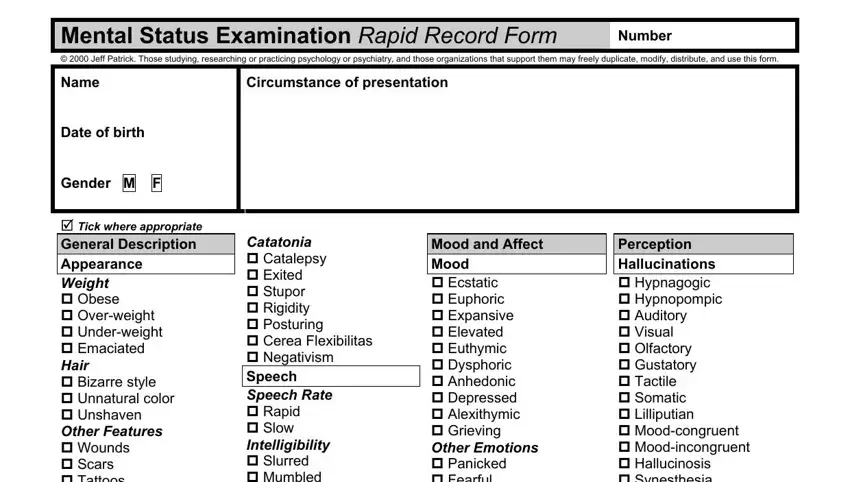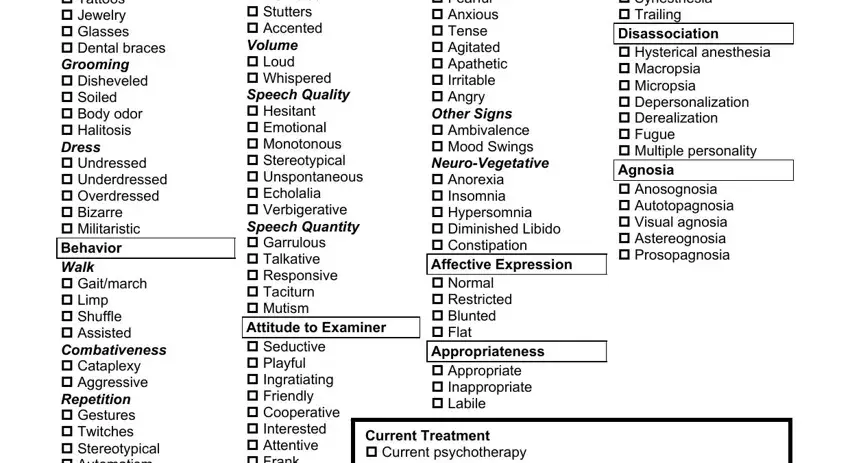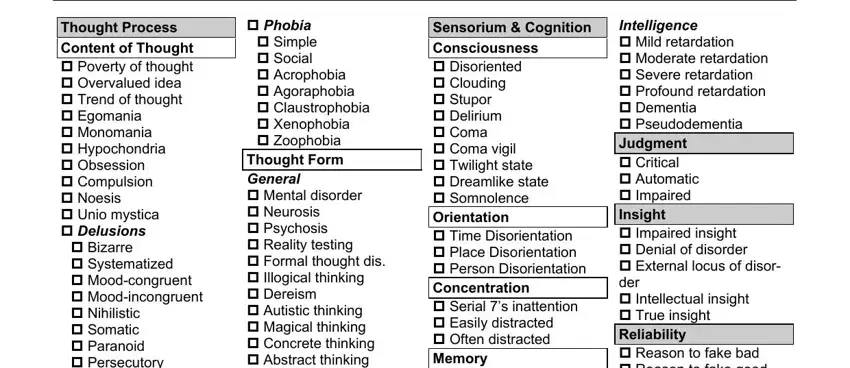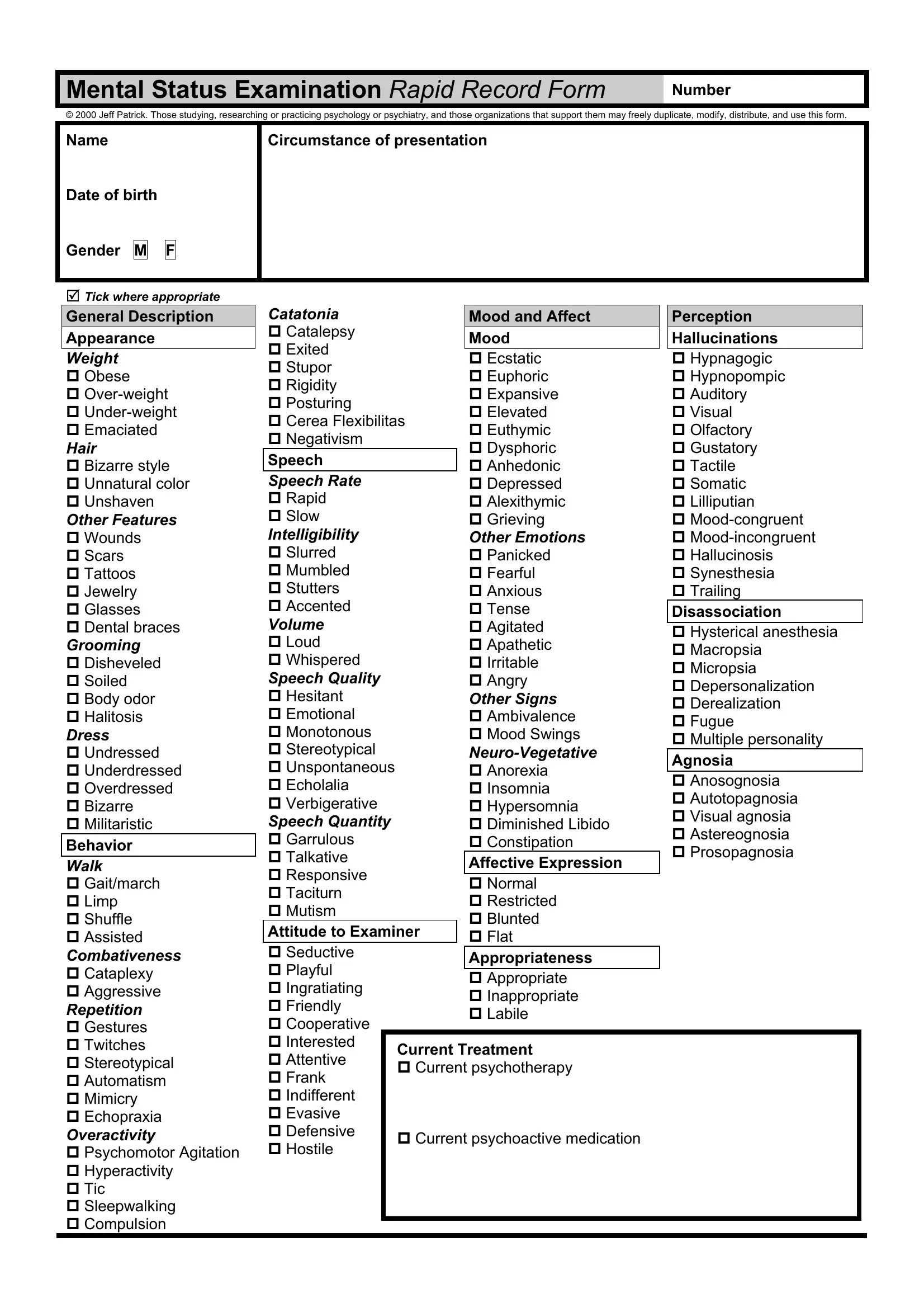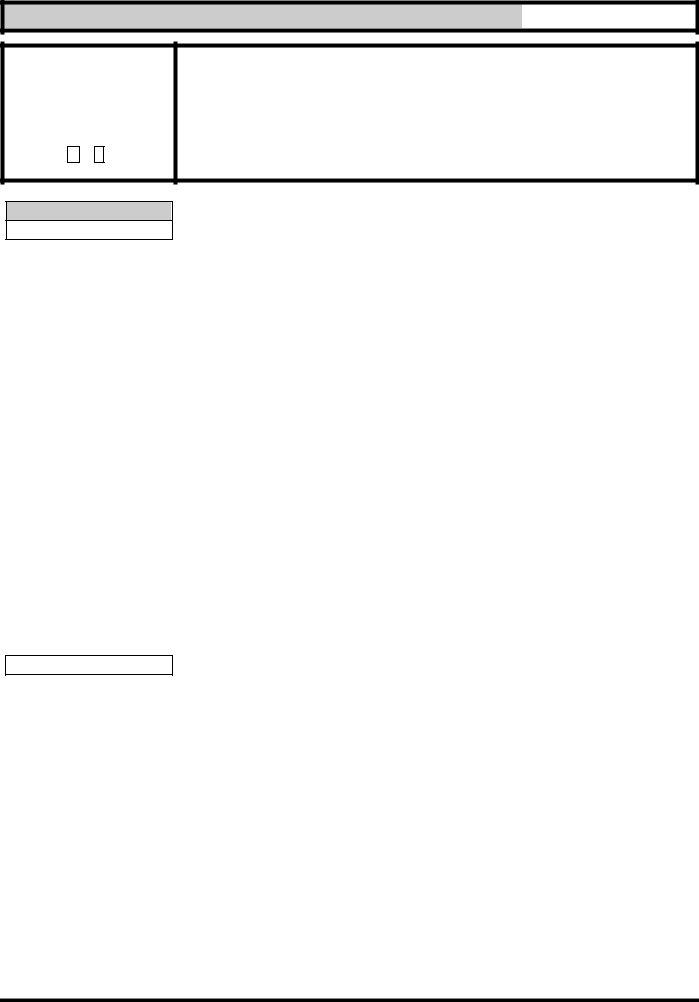Selected glossary
Abstract thinking. Thinking characterised almost exclu- sively by cognitive abstractions, rather than immediate sensory experience.
Acrophobia. Fear of heights.
Affect. The pattern of observable behaviours which is the expression of a subjectively experienced feeling state (emotion) and is variable over time in response to changing emotional states.
Agoraphobia. A fear of being in places or situations in which escape might be difficult or embarrassing, or in which help may not be available should a panic attack occur.
Alexithymic. Relatively undifferentiated emotions (unable to identify or express emotion), and thinking tends to dwell excessively on the mundane. Detached, and may seem to dissociate.
Anhedonic. An inability to enjoy anything, even things once enjoyed.
Anosognosia. Ignorance of the presence of disease, specifically of paralysis.
Astereognosia. The inability to recognise common objects by touch.
Autistic thinking. An abnormal absorption with the self, marked by interpersonal communication difficulties, a short attention span, and inability to treat others as people.
Automatism. Automatism refers to activity performed without conscious awareness and usually followed by complete amnesia.
Autotopagnosia. A condition where one cannot identify or describe their own body parts. Individuals can dress themselves appropriately and use their body normally, but they cannot talk about their bodies.
Bizarre Delusion. A delusion that involves a phenomenon that the person's culture would regard as totally im- plausible.
Blocking. Repeated and abrupt halt to speech as a result of losing one's train of thought.
Catalepsy. A trancelike state with loss of voluntary motion and failure to react to stimuli.
Cataplexy. Sudden, dramatic decrement in muscle tone & loss of deep reflexes that leads to muscle weakness, paralysis, or postural collapse. Usually caused by out- burst of emotion: laughter, startle, or sudden physical exercise; one of the symptoms of narcolepsy.
Cerea Flexibilitas. Waxy flexibility in which a limb remains where placed; often seen in catatonia.
Circumstantiality. Slowed thinking incorporating unneces- sary trivial details. Eventually the goal of the thought is reached.
Clang association. Speech in which words are chosen because of their sounds rather than their meanings.
Claustrophobia. Fear of being trapped in confined spaces.
Coma vigil. Awake, but without conscious awareness. In this vegetative state persons can open their eyelids occasionally and demonstrate sleep-wake cycles. They also completely lack cognitive function.
Compulsion Catatonia. Muscular rigidity; a tendency to remain in a fixed stuporous state for long periods; the catatonia may give way to short periods of extreme excitement.
Compulsion. Repetitive ritualistic behaviour or mental activity.
Concrete thinking. Thinking characterised almost exclu- sively by immediate sensory experience, rather than cognitive abstractions.
Condensation. Speech in which two or more separate concepts are not differentiated.
Confabulation. A plausible but imagined memory that fills in gaps in what is remembered.
Control Delusion. The belief that one’s thoughts or actions were under some outside control.
Déjà entendu. Subjectively inappropriate impression of familiarity of something just heard with an undefined memory of same.
Déjà pense. Subjectively inappropriate impression of familiarity of something just thought with an undefined memory of same.
Déjà vu. Subjectively inappropriate impression of familiarity of a present experience with an undefined past.
Depersonalization. A loss of contact with one’s personal reality. Detachment from self.
Derailment. A pattern of speech in which a person's ideas slip off one track onto another that is completely unre- lated.
Derealization. Feelings of unreality or strangeness.
Dereism. A loss of connection with reality and logic, where thoughts become private and idiosyncratic (odd or pe- culiar).
Dysarthria. Difficulty producing speech. Dysphoric. Feeling unwell or unhappy.
Dysprosody. A speech impairment characterised by a loss of control of intonation and rhythm.
Echolalia. The repetition or echoing of verbal utterances made by another person.
Echopraxia. Involuntarily imitation the movements of another. Echopraxia is also known as echomotism.
Ecstatic. A sensation of being carried away by overwhelm- ing delight.
Egomania. Preoccupation with oneself.
Eidetic images. The ability to retain an accurate, detailed visual image of a complex scene or pattern (some- times popularly known as photographic memory).
Erotomania. Excessive sexual desire, or exaggerated belief in one’s sexual conquests or ability.
Euphoric. An exaggerated feeling of well-being or elation. Euthymic. Mood in the normal range, neither depressed or
elevated.
Fausse reconnaissance. Delusional (false) recognition of persons or places.
Flight of ideas. Speech consists of a stream of acceler- ated thoughts with abrupt changes from topic to topic and no central direction.
Folie à deux. The sharing of a fantasy by two closely associated friends.
Formal thought disorder. A disturbance in the form of thinking rather than an abnormality of content.
Fugue. A condition in which an individual suddenly aban- dons a present activity or lifestyle and starts a new and different one for a period of time.
Garrulous. Given to excessive and often trivial or rambling talk; tiresomely talkative.
Global Aphasia. The loss of all ability to communicate. Glossolalia. Fabricated, meaningless speech. Gustatory Hallucination. Hallucination of taste. Halitosis. Bad breath.
Hallucinosis. A mental state in which the person has continual hallucinations.
Hypermnesia. Extreme power of memory. A capacity for immediate registration and precise recall of much more detail than is thought possible under ordinary circumstances.
Hypnagogic Hallucination. Threatening hallucinations at the moment of falling asleep.
Hypnopompic Hallucination. Threatening hallucinations at the moment of waking from sleep.
Hypochondria. Abnormal anxiety about one's health; the persistent neurotic conviction that one is or is likely to become ill.
Hysterical anaesthesia. Sensory loss due to a mental state.
Infidelity Delusion. The belief that one’s partner is sexu- ally unfaithful.
Jamais vu. The experience of being unfamiliar with a person or situation that is actually very familiar.
Jargon Aphasia. Incoherent, meaningless speech.
Labile. Repeated and rapid shifts from one extreme to another.
Lilliputian Hallucination. Hallucination that people or objects are smaller than they are.
Loosening. Speech characterised by slipping from one train of thought to another loosely related train of thought.
Macropsia. Seeing everything in the field of view as larger than it really is.
Magical thinking. The belief that one's thoughts, words, or actions will cause or prevent a specific outcome in some way that defies commonly understood laws of nature.
Micropsia. Seeing everything in the field of view as smaller than it really is.
Monomania. Preoccupation with a single object. Mood-congruent Hallucinations. Hallucination in which
the content is mood appropriate.
Mood-incongruent Hallucinations. Hallucination in which the content is not mood appropriate.
Motor Aphasia. A condition in which expression by speech or writing is severely impaired.
Multiple personality. Two or more distinct personalities alternately prevail in the same person.
Mutism. Unable or unwilling to speak.
Negativism. Opposition or resistance, either covert or overt, to outside suggestions or advice.
Neologism. The use of a newly made up word, or an everyday word used in an idiosyncratic way.
Nihilistic Delusion. The delusion of non-existence of the self, or part of the self.
Noesis. The belief that one has a divine calling. Obsession. A recurrent and persistent thought, impulse, or
image.
Overvalued idea. An unreasonable and sustained belief that is maintained with less than delusional intensity.
Paramnesia. False recollection of events that have never occurred.
Perseveration. Mental operations carry on past the point that they serve a function. E.g. What day is it? Mon- day. What time is it? Monday.
Poverty of Content. Speech that conveys little information because it is vague or baron.
Poverty of Speech. Less speech than normal.
Poverty of thought. Speech that conveys little information because of vagueness, empty repetitions, or stereo- typed or obscure phrases.
Prosopagnosia. The inability to recognise familiar faces, although they react physiologically as if they do recog- nise the person.
Pseudodementia. A severe form of depression in which cognitive changes mimic those of dementia.
Pseudologia fantastica. Grossly exaggerating medical symptoms or personal details.
Psychomotor Agitation. Describes a morbid increase in action or movement presumed to result from psychic rather than physical (organic) disturbance.
Reality testing. The lack of ability to evaluate the external world objectively and to differentiate adequately be- tween it and the internal world.
Referential Delusion. A delusion centred on the idea that events, objects, or other persons in one's environment have a particular and unusual significance.
Retrospective falsification. Where the person changes the reporting of past events, or now has only selective memory of what was more fully remembered previ- ously.
Sensory Aphasia. A condition characterised by fluent but meaningless speech and severe impairment of the ability understand spoken or written words.
Somatic Delusion. A delusion whose main content per- tains to the appearance or functioning of one's own body.
Somatic Hallucination. Hallucination involving the sensa- tion of being strangled, feeling that insects are crawl- ing beneath the skin, or feelings of sexual stimulation.
Somnolence. A very sleepy state.
Synesthesia Hallucinations. The hallucination of a sense other than the one being stimulated. For example, a sound may evoke sensations of colour.
Syntactical Aphasia. Difficult in arranging words in their correct sequence.
Systematised Delusion. A single false belief with multiple elaborations or a group of false beliefs that the person relates to a single event or theme.
Taciturn. Habitually untalkative.
Tactile Hallucination. Hallucination of touch. Tangentiality. Replying to a question in an oblique or
irrelevant way.
Thought broadcasting. The belief that one's thoughts are being broadcast out loud so that they can be per- ceived by others.
Thought insertion. The belief that certain of one's thoughts are not one's own, but rather are inserted into one's mind.
Thought withdrawal. The belief that one would like to think a thought, but someone or something has re- moved the thought.
Tic. Part of the body moves repeatedly, quickly, suddenly and uncontrollably.
Trailing Hallucinations. Hallucination that moving objects are seen as a series of discrete discontinuous images.
Trend of thought. Thinking with a tendency toward or centring on a particular idea with a particular affect.
Unio mystica. The belief that one has a unity or union by secret rites. More generally, the unity or union in the spirit of an individual with that of the Supreme Being or some other superior or leader.
Verbigerative. Involuntarily repeating of certain words and/or phrases.
Visual agnosia. The inability to recognise common objects by sight.
Voluble. Dominates conversation with a ready flow of speech.
Word salad. Speech that is an incoherent and incompre- hensible mix of words and phrases.
Xenophobia. Fear of strangers or foreigners. Zoophobia. Fear of animals.
